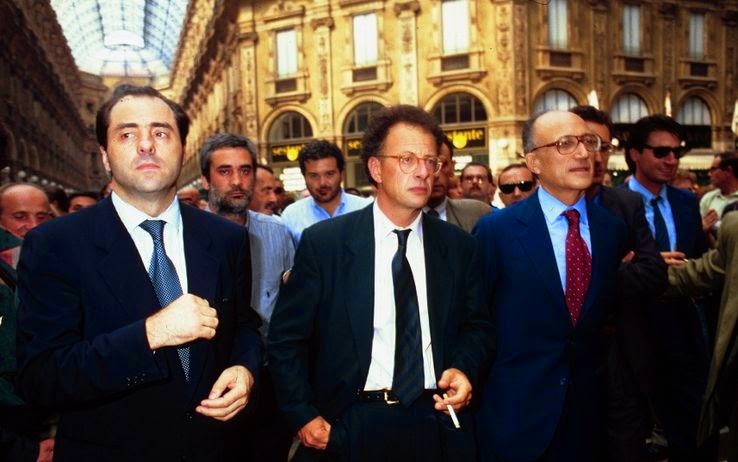Italy's 'Tangentopoli' Scandal - 1992.
“1992”.
For many of you it’s just a number, or more likely, a year. What happened? Probably you’re thinking about the separation of Prince Charles and Princess Diana, or that John Major was Prime Minister, or even Britain’s infamous currency crash. But during 1992, in another EU nation, a crisis was brewing - the year when Italy became aware of the corruption inside her political world and, moreover, the year when the biggest political scandal in history came to light.
 |
| On the left: Antonio Di Pietro, Gherardo Colombo and Francesco Saverio Borrelli. |
“Mani Pulite” (literally “clean hands”), better known as Tangentopoli, was an investigation that, before it was over, would see many influential members of Italy’s political and industrial spheres imprisoned for the first (and not the last) time.
Everything started on the 17th of February, when Antonio Di Pietro, the prosecutor who started the investigations, arrested Mario Chiesa, a member of the PSI (Italian Socialist Party), while he was accepting a bribe. What a surprise.
 |
| Antonio Di Pietro |
In a couple of months, Italy’s already tumultuous political world began to crumble and during the elections in April the two most important and powerful parties in Italy, the PSI and the Christian Democracy, lost a large portion of their seats in Parliament. Small parties, such as Lega Nord ( or “North League”) took advantage of this unstable situation to curry favour with the electorate and earn votes.
Immediately after the elections, many politicians and industrial leaders were arrested, accused of corruption. What helped Di Pietro and his team were the testimonies of the detained individuals, who quickly sold out their contacts and blamed each other to get their freedom again.
A feeling of repulsion against politics and especially politicians was spreading throughout the country and many people showed support to Di Pietro and his team. In fact, the prosecutor was seen as a hero that was fighting to set free Italy.
 |
| Antonio Di Pietro |
Things moved rapidly, and by the 25th of April, Italy’s Liberation Day and the Anniversary of the Resistance, the President of the Republic Francesco Cossiga announced his resignation. Coincidental, much?
A month later, Oscar Luigi Scalfaro was elected Head of the Republic, with the disapproval of the majority of the parties.
Tensions began to rise following a Mafia threat against Di Pietro’s life. This closely followed the rejection of a new law that would’ve exonerated every Tangentopoli suspect (the “Conso decree”, or “Clean Slate”). The law gained momentum because of the ‘Stagione dei Suicidi’ or ‘Season of Suicides’, where many of the accused took their own lives rather than face the charges brought against them.
The investigations finished in 1996/97 with the decline in popularity of the “revolution of the judges” and the victory of the powerful (and political) men. Some influential figures, most notably Bettino Craxi, leader of the PSI, escaped justice because of the apparent tardiness of the authorities in leveling charges against him. Craxi soon fled Italy and lived the rest of his years as an exile.
 |
| "1992" on Sky Atlantic. On the left: Guido Caprino, Tea Falco, Alessandro Roja, Domenico Diele, Miriam Leone, Stefano Accorsi. |
All these events are brought to the fore and narrated in “1992”, an Italian TV show and brainchild of Italy’s famous televisual polymath Stefano Accorsi.
Real and fictional characters are mixed to give the viewer an idea of what happened in Milan at that time. It also tackles the endemic corruption that was occurring in Italian show-business during the 90s. The problem was simple: a woman didn’t have to be talented to host a program or have popularity. She simply needed to be pretty and be intimate with the right men. Some might say that not much has changed from 23 years ago.
 |
| A still from "1992". |
There’s an expression that says: “You learn from your mistakes”.
Well, Italy is the exception that confirms the rule.


Comments
Post a Comment